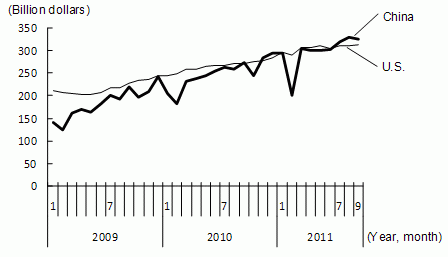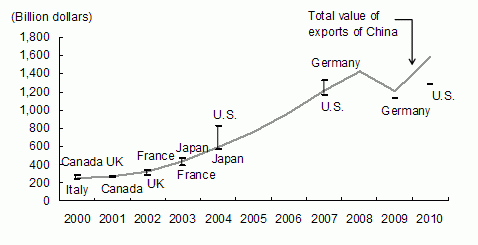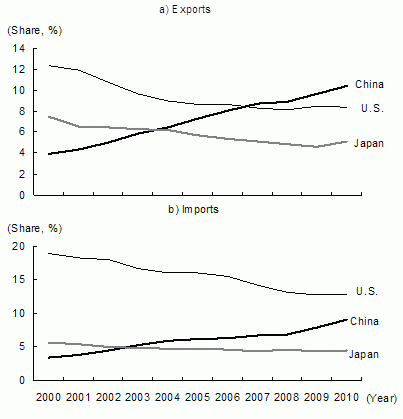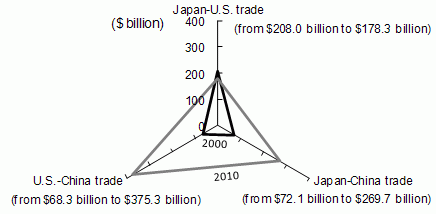Since the launch of its reform and open-door policies, China has been integrating its economy with the world economy through trade liberalization and the acceptance of direct investments. The pace has been further accelerating, following its accession to the World Trade Organization (WTO) in 2001, and China will soon become the world's biggest trade power, overtaking the United States. With this as a backdrop, the importance of China as not only a major supplier but also an export market has been increasing for major countries including Japan and the United States. Trades between the United States and China and between Japan and China have surpassed that between the United States and Japan to become the center of transpacific trade. Furthermore, China has also been increasing its importance not only as the workshop of the world but also a market for the world.
China is becoming the world's biggest trade power
Exports and imports of China totaled $20.6 billion in 1978, ranking 29th in the world. As late as 2001, China still ranked sixth. By 2010, however, its exports and imports reached $1.58 trillion and $1.39 trillion, respectively, for total trade of $2.97 trillion, ranking second in the world after the United States (which had exports and imports of $1.28 trillion and $1.91 trillion, respectively, totaling $3.19 trillion). The monthly data of exports and imports show that the gap with the United States narrowed in 2011 and that the positions of both countries have reversed since July. On an annual basis, China is set to become the world's biggest trade power as early as 2011 or 2012 at the latest, surpassing the United States (Figure 1).
Figure 1: China Surpasses the U.S. in Trade Volume |
 |
| (Note) Trade volume is the sum of export value and import value. |
| (Source) Based on customs statistics of China and the United States |
Regarding exports, China ranked seventh in the world in 2000 in total value of exports, moving to sixth in 2001 when it became a member of the WTO and overtook Canada; fifth in 2002, surpassing United Kingdom; fourth in 2003, passing France; third in 2004, moving past Japan; second in 2007, overtaking the United States; and finally supplanting Germany in 2009 to become first in the world (Figure 2).
Figure 2: Changes in Total Value of Exports of China and its World Ranking |
 |
| (Source) Based on annual editions of International Trade Statistics, WTO |
As its trade volume has expanded rapidly, China's share of world trade has also been increasing. From 2000 to 2010, China's share of global exports rose from 3.9% to 10.4%, while its share of global imports climbed from 3.4% to 9.1% (Figure 3). In contrast, the shares of the United States and Japan have been declining significantly in terms of both global exports and imports.
Figure 3: Japan, the U.S., and China: Changes in Share of Total World Trade |
 |
| (Source) Based on annual editions of International Trade Statistics, WTO |
Major shifts in transpacific trade
Based on these changes, the importance of China as a trading partner is rising for major developed countries, including Japan and the United States (Table 1).
Table 1: Overview of Trade Among China, the U.S., and Japan (Comparison of 2010 with 2000) |
 |
| (Note) Export and import values of Japan are converted from yen to dollars, using the average exchange rate in each year. Figures in parentheses are shares of the world. |
| (Source) Based on customs statistics of China, the United States and Japan |
First, from 2000 to 2010, the percentage that China accounts for of the U.S. exports rose from 2.1% to 7.2%, while that of the U.S. imports increased from 8.2% to 19.1%. For the United States, China has already become the largest supplier, overtaking Canada and Mexico, its neighboring countries. On the other hand, the export dependency of the United States on Japan dropped from 8.3% to 4.7%, while import dependency also declined from 12.0% to 6.3%.
During the same period, the share represented by China of Japanese exports also climbed, from 6.3% to 19.4%, while that of Japanese imports rose from 14.5% to 22.1%. In contrast, the share represented by the United States of Japanese exports declined from 29.7% to 15.4%, while that of Japanese imports fell from 19.0% to 9.7%. China has been Japan's largest supplier since 2002, supplanting the United States, and Japan's exports to China exceeded those to the United States in 2009.
For China, on the other hand, the importance of Japan and the United States as trading partners has been declining. From 2000 to 2010, the shares represented by the United States and Japan in Chinese exports fell from 20.9% to 18.0% and from 16.7% to 7.7%, respectively. The shares both countries have of Chinese imports have also declined, from 9.9% to 7.3% and from 18.4% to 12.7%, respectively.
Not only has the mutual export and import dependency of the United States and Japan on each other been declining, but also the absolute amount of trade between them has been shrinking. Clearly, the central element of transpacific trade has been shifting from trade between Japan and the United States to that between the United States and China and between Japan and China (Figure 4).
Figure 4: The Changing Shape of the Trade Triangle between Japan, the U.S., and China —Comparison of Japan-U.S., Japan-China, and U.S.-China Trade Values Between 2010 and 2000— |
 |
| (Note) Figures are the sum of exports and imports, and are calculated based on exports of both parties (For example, the Japan-China trade value is the sum of exports from Japan to China and exports from China to Japan). The export value of Japan is converted from yen to dollars, using the average exchange rate in each year. |
| (Source) Based on the customs statistics of China, the United States and Japan |
From "workshop of the world" to "market for the world"
Against this backdrop of rapid growth in exports of industrial products, China has been known as the workshop of the world since around 2001, when it joined the WTO. Although both exports and imports of China have been increasing, among imports, the percentage of intermediate goods has been greater than that of finished products for the domestic market, reflecting the extremely high weight of processing trade. As incomes grow, however, the attractiveness of China as a market for finished products is also increasing. In fact, processing trade as a share of China's imports has been declining, from 41.1% in 2000 to 30.0% in 2010. In its place, the ratio of non-processing trade is rising, and in proportion to this, the percentage of finished products for the domestic market is also estimated to be increasing.
In terms of direct investments, China is increasing its importance not only as a production base but also as a market for finished products. The "Quarterly Survey of Overseas Subsidiaries" of the Ministry of Economy, Trade and Industry shows that the percentage of the output of Japanese companies in China (including Hong Kong) being directed towards local sales has risen from 35.1% in 2002 to 63.4% in 2010. Particularly in the case of automobiles, not only Japanese manufacturers but also foreign automakers are selling most of the automobiles manufactured in China locally. China became the world's largest auto market in 2009, overtaking the United States, reaching 18.06 million vehicles in 2010 (compared to 11.77 million vehicles for the United States).
In this way, China is solidifying its position as a market for the world, together with its role as the workshop of the world. China already has the world's second-largest GDP, overtaking Japan. Given expectations that China will continue to grow at a faster pace than developed countries and that its growth engine will shift from external demand to domestic demand, its ability to drive the world economy is likely to grow increasingly stronger.
The original text in Japanese was posted on November 30, 2011


